On this page you’ll find a complete guide to playing the natural minor scale (also known as the Aeolian scale) on guitar. We start with a basic natural minor scale guitar pattern, then introduce additional fretboard patterns that will allow you to play the scale all over the guitar neck. Practice using the scale with the backing track provided...
What you’ll learn
- The basic natural minor scale guitar pattern.
- Four more natural minor scale fretboard patterns.
- Why learning more than one scale pattern is beneficial.
- How the natural minor scale is constructed.
- When to use the natural minor scale
- You’ll also be able to practice soloing with a natural minor scale using the backing track provided.
Let’s get started…
Page Index
- Natural Minor Scale Guitar Backing Track
- About The Natural Minor Scale
- Basic Natural Minor Guitar Pattern
- 2-Octave C Natural Minor Scale TAB (Up & Down)
- 2-Octave G Natural Minor Scale TAB (Up & Down)
- All Natural Minor Scale Patterns
- Why learn more than one pattern for each scale?
- Joining Multiple Natural Minor Scale Guitar Patterns
- 3 Octave Natural Minor Scale Using Multiple Patterns
- Notes In A Natural Minor Scale
- How To Use The Natural Minor Scale
- More Guitar Scale Pages At Guitar Command
Natural Minor Scale Guitar Backing Track
Once you’ve learned the natural minor scale patterns on this page, you can use them to play along to this backing track. It’s in C, so improvise using the C natural minor scale.
(You could also throw in some C pentatonic minor or C blues scale licks; when playing blues you can often mix natural minor, minor pentatonic and blues scales.)
About The Natural Minor Scale
The natural minor scale is a useful scale for soloing over songs in minor keys. Although it’s not quite as ‘characterful’ as other minor scales such as the Dorian scale or the harmonic minor scale, its ‘neutral’ sound can be an advantage.
The natural minor scale will often sound better than other minor scales because it contains fewer potentially 'awkward' notes that will jar against certain chords.
Here are two things you should know about the natural minor scale:
- Natural minor scales contain the same notes as the major scales with tonic notes a minor third higher (e.g. an A natural minor scale contains the same notes as a C major scale, a D natural minor scale contains the same notes as an F major scale, etc.). They just start and end on different notes.
- Natural minor scales are synonymous with Aeolian scales with the same tonic notes (e.g. an A natural minor scale = an A Aeolian scale).
Basic Natural Minor Guitar Pattern
Get to know the sound of the natural minor scale by playing the pattern below. Further down the page you’ll find four additional natural minor patterns and tabs.
- You can find out how to read scale patterns on this page: Guitar Scale Patterns

The fingering shown in the diagram above can be used to play a natural minor scale in any key.
Play it at the 8th fret for a 2-octave C natural minor scale, as shown in the TAB below. (At the 8th fret the green tonic notes as shown on the diagram will be positioned over ‘C’ notes on the fretboard.)
2-Octave C Natural Minor Scale TAB (Up & Down)
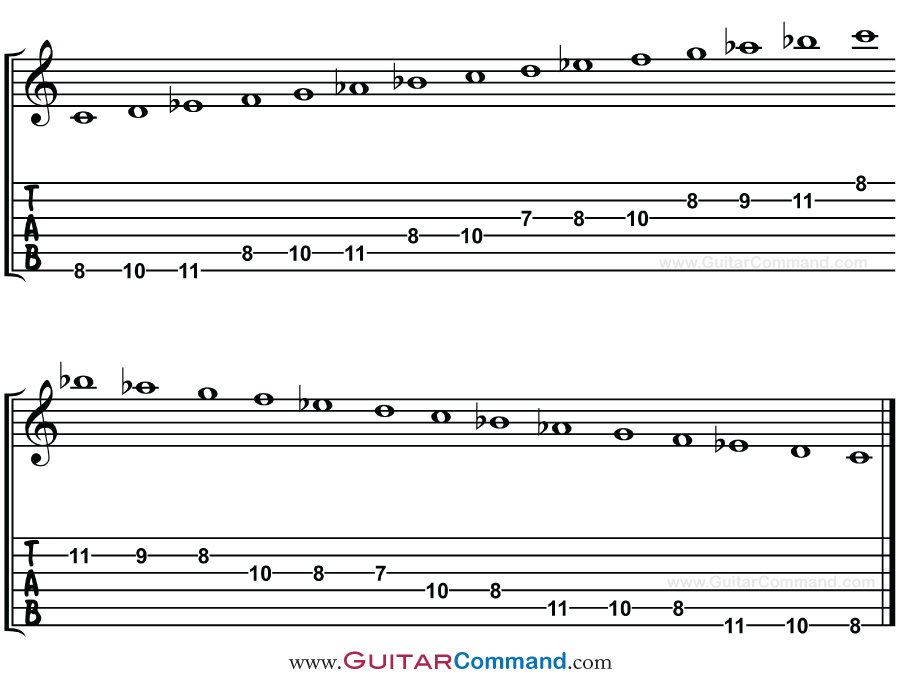
You may have noticed that the scale pattern above includes 2 additional notes that extend the scale beyond the second octave.
Scale diagrams often include notes that are either above or below the tonic notes in this way. This is because you’ll usually be using the scale while improvising, so knowing the extra notes available in that fretboard position can be useful.
If you just want to play the scale then start and stop on the green tonic notes.
- You can find out how to read guitar tab here: How To Read TAB
2-Octave G Natural Minor Scale TAB (Up & Down)
Here’s the same natural minor scale pattern being used to play a G natural minor scale:
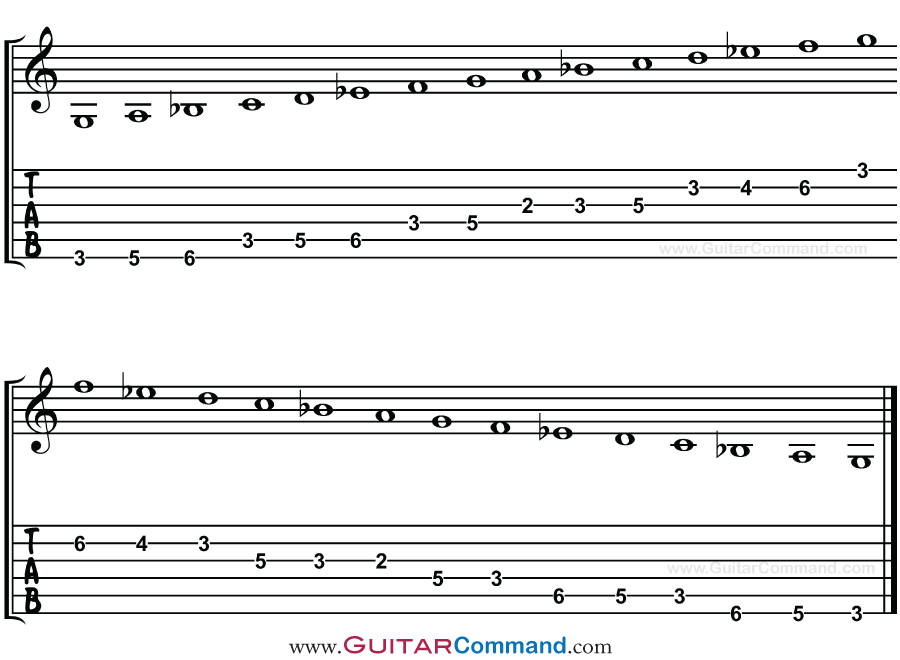
All Natural Minor Scale Patterns
The diagram below shows the first natural minor scale pattern together with four more patterns. We’ll take a closer look at each of the new patterns below.
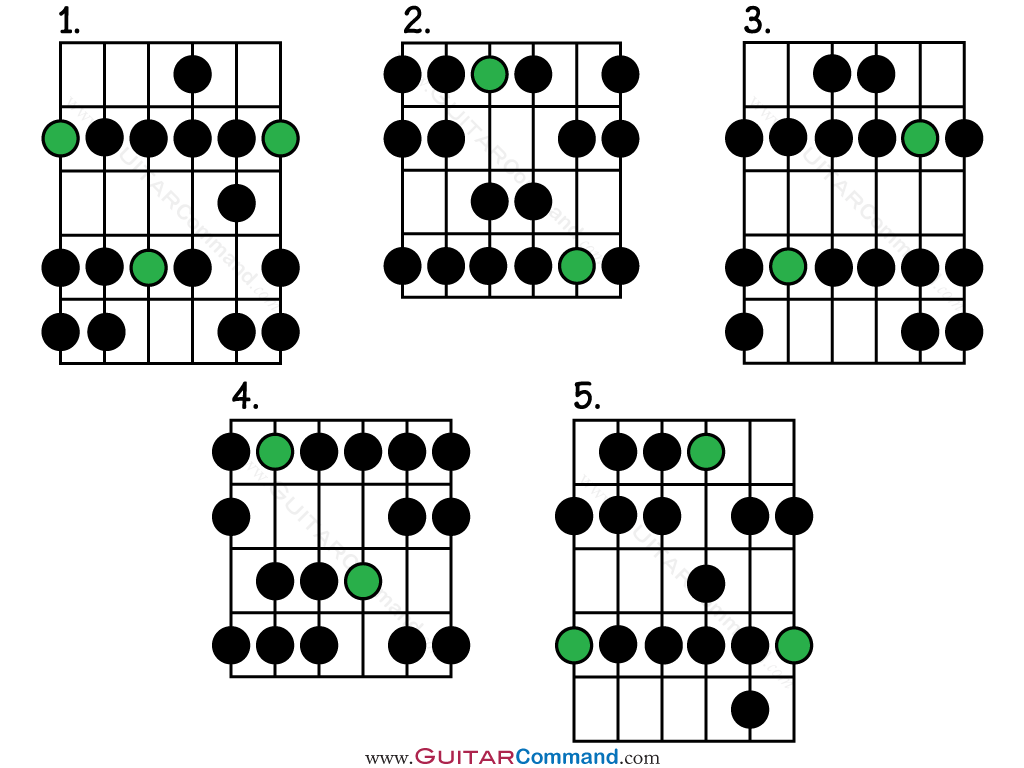
The basic natural minor scale pattern (pattern 1) can be extended up and down the guitar fretboard using the additional scale patterns. You’ll see how to join the patterns up in order to create longer lines further down the page.
A tab example has been provided for each of the new patterns. The tab shows how the pattern can be used to play either a 1 octave or a 2 octave C natural minor scale. (Patterns 1 & 5 span 2 octaves, the others a single octave.)
Remember that the scale patterns may contain notes that extend the scale, either upwards or downwards. If you just want to play a single octave, play from a green note to the next green note, as shown in the tabs below.
Natural Minor Scale Pattern 2
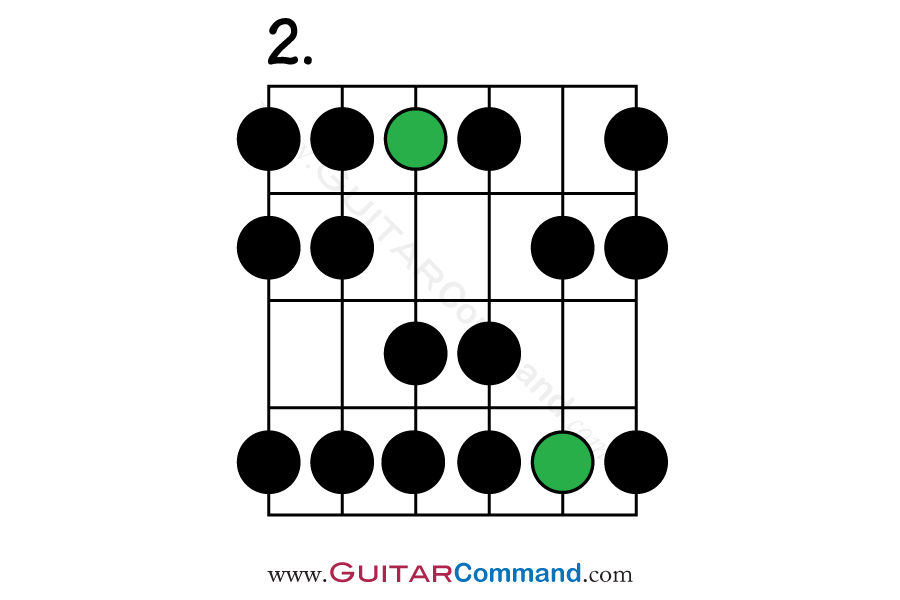
Play this pattern in 10th position (i.e. position your hand so that the index finger is ready to play at the 10th fret), starting and stopping on the green notes, for a 1-octave C natural minor scale:
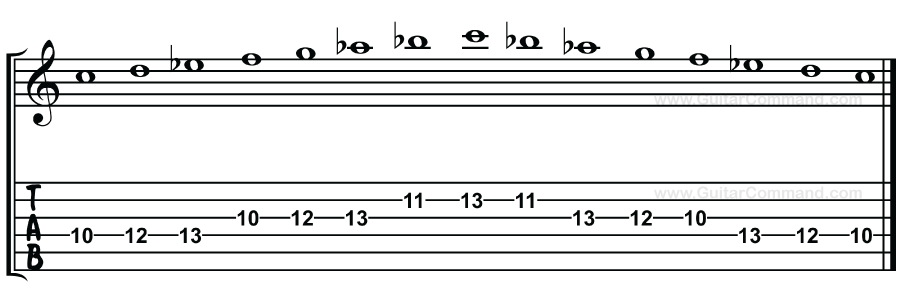
Natural Minor Scale Pattern 3

The TAB below shows how pattern 3 can be used to play a 1-octave C natural minor scale in open position. (You could play the same scale an octave higher by using the pattern starting on the C at the 15th fret of the 5th string.)
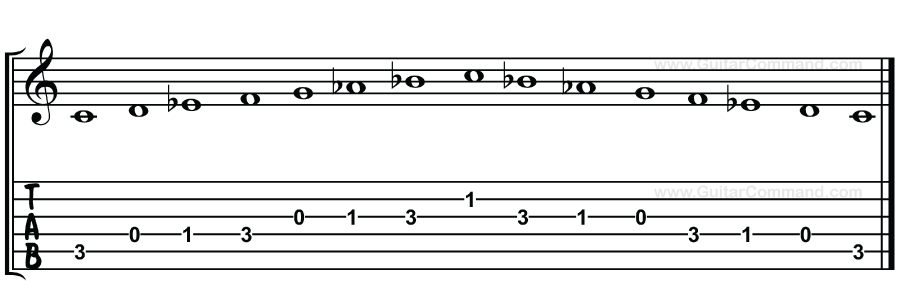
Natural Minor Scale Pattern 4
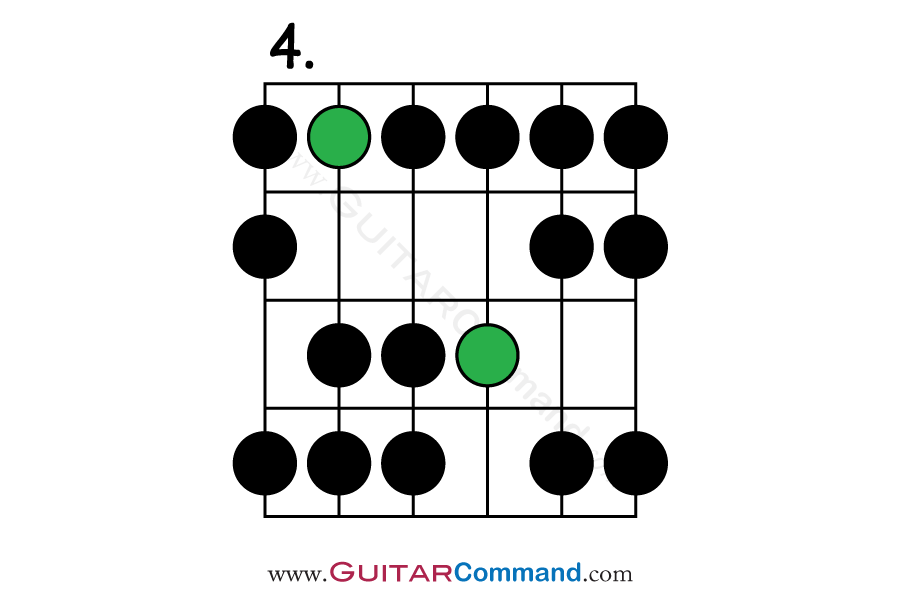
Play this pattern at the 3rd fret for a C natural minor scale, as shown in the TAB below:
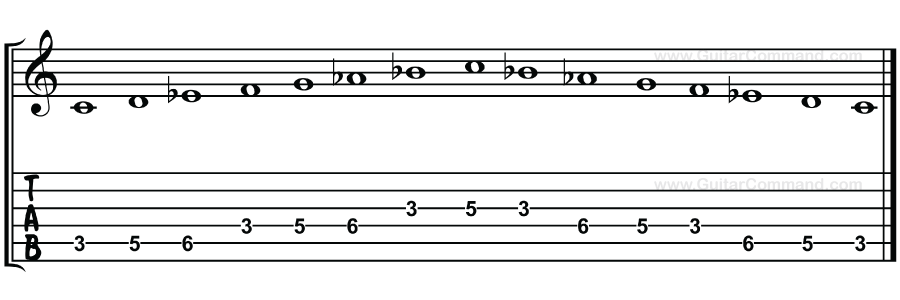
Natural Minor Scale Pattern 5

Playing this pattern in 5th position will result in a C natural minor scale, as shown in the TAB below:
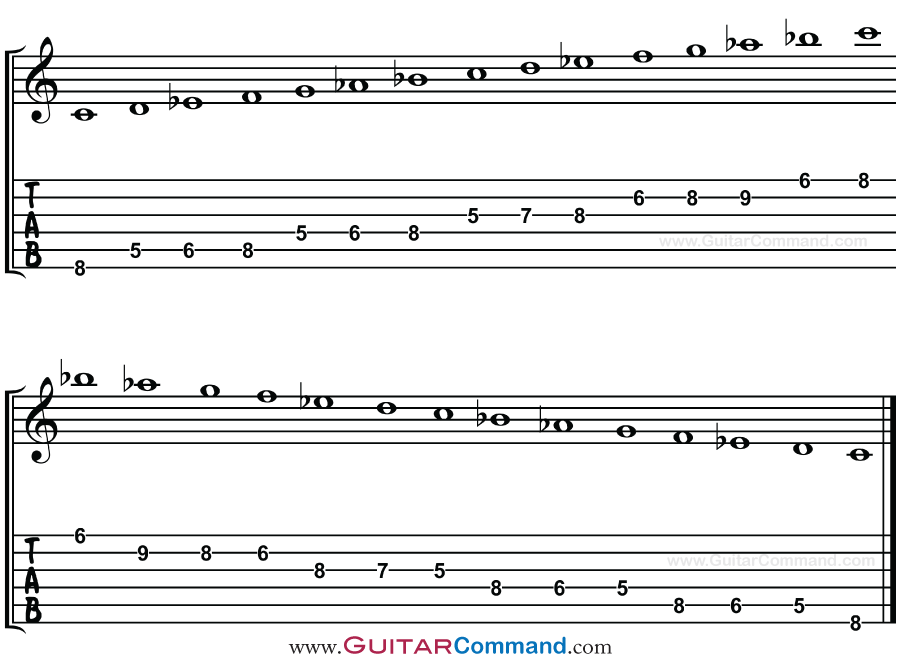
Why learn more than one pattern for each scale?
Guitarists learn more than one scale pattern for each scale so that they can play the scale in different octaves and at different positions on the guitar neck.
For example, if you only knew the basic natural minor scale pattern (pattern 1) and were improvising over a chord progression in C, then you’d be limited to playing in 7th or 8th position (i.e. with your index finger positioned over the 7th or 8th frets.)
If you also knew natural minor scale pattern no. 3, then you could also improvise using a C natural minor scale in open position, or in 12th / 13th position. This would give you access to several more notes.
Joining Multiple Natural Minor Scale Guitar Patterns
When playing with scales, you can extend your lines by linking together adjacent scale patterns. Below you’ll find a TAB example of this, with suggested fingerings.
3 Octave Natural Minor Scale Using Multiple Patterns
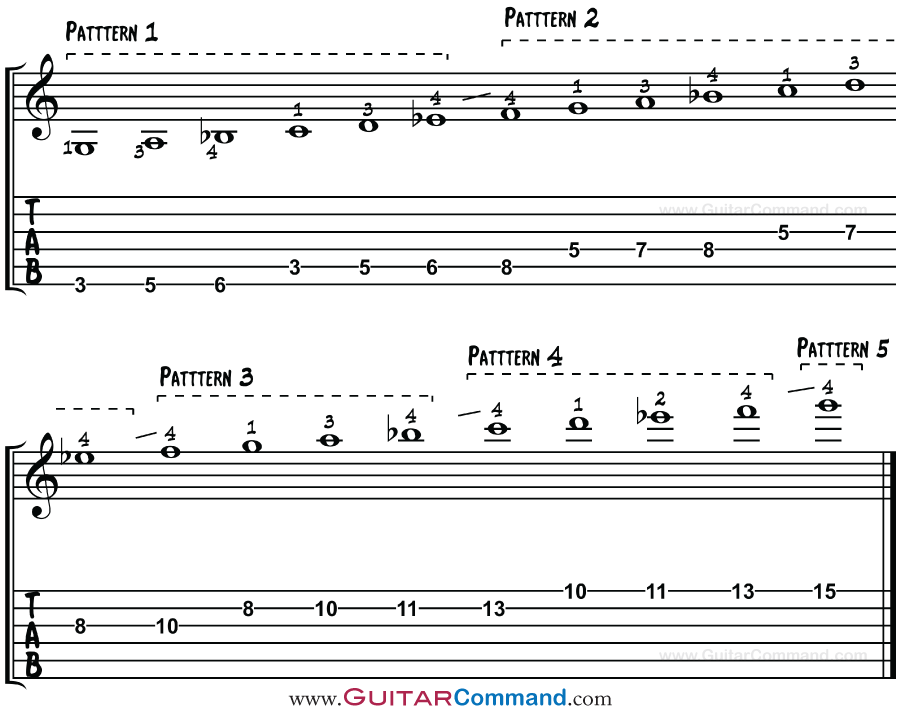
This is just one of many ways you can join natural minor scale patterns up to make longer lines.
Experiment linking each of the five patterns with its neighboring patterns to create your own extended lines.
Notes In The Natural Minor Scale
The natural minor scale comprises the following notes / intervals:
- Tonic note
- Major 2nd
- Minor 3rd
- Perfect 4th
- Perfect 5th
- Minor 6th
- Minor 7th
Its scale spelling is: 1, 2, b3, 4, 5, b6, b7
Therefore, the notes in a C natural minor scale are:
- Tonic note = C
- Major 2nd = D
- Minor 3rd = E flat
- Perfect 4th = F
- Perfect 5th = G
- Minor 6th = A flat
- Minor 7th = B flat
… and the notes in G natural minor scale are:
- Tonic note = G
- Major 2nd = A
- Minor 3rd = B flat
- Perfect 4th = C
- Perfect 5th = D
- Minor 6th = E flat
- Minor 7th = F
How To Use Natural Minor Scales
The natural minor scale, when compared to other scales with a minor tonality such as the Dorian scale, jazz minor scale and the harmonic minor scale, has a somewhat ‘neutral’ tone.
This makes it less ‘characterful’ but perhaps more versatile, as it can be used over a greater number of chord progressions in the rock / pop genre.
The natural minor scale contains the same notes as the major scale with a tonic note a minor third higher (e.g. an A natural minor scale contains the same notes as a C major scale, but starting on A rather than C).
Because of this, the natural minor scale can be used to solo over chord progressions than contain chords that are diatonic to the major scale a minor third higher.
- You can find out what diatonic chords are here: Diatonic Chords
For example, you could use A natural minor scale to solo over the following chord progression, because all of the chords are diatonic to C major.
||: Am | G | F | Em | G | Dm | Am | Am :||
Discover More Guitar Scales At Guitar Command
Visit the following pages on Guitar Command to find out more about guitar scales and how to use them in your own playing:

